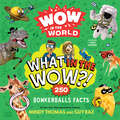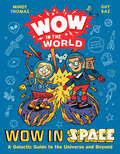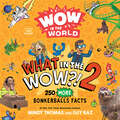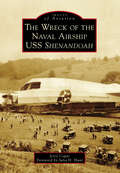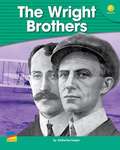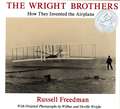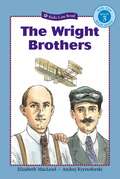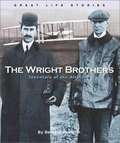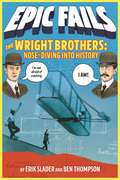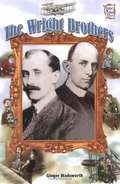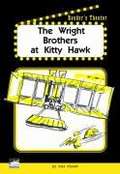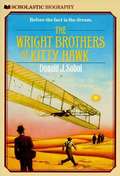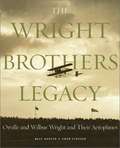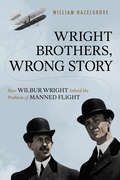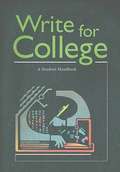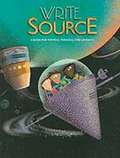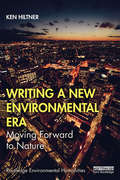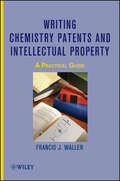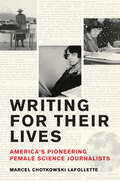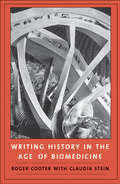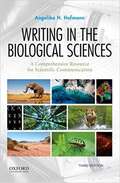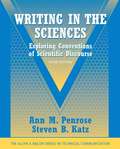- Table View
- List View
Wow in the World: 250 Bonkerballs Facts (Wow in the World)
by Mindy Thomas Guy RazFrom #1 New York Times bestselling authors Mindy Thomas and Guy Raz, hosts of the #1 kids podcast Wow in the World, comes a book bursting with 250 awe-inspiring, jaw-dropping science facts, photos, and illustrations.What in the wow is a “grumble” of pugs?Where in the wow can you sleep in a potato?Why in the wow is there poop on the moon?And how in the wow is a banana a berry?!From skunks who do handstands to a bridge made with eggs, the world is full of wowzerful stuff! Mindy Thomas and Guy Raz, hosts of the #1 children's podcast Wow in the World, are here with 250 of the most bonkerballs facts on Earth, covering topics such as animals, architecture, inventions, food, space, dinosaurs, and more!Filled with eye-popping photos and hilarious illustrations, this is a page-turning, jaw-dropping survey of some of the most astounding, gross, and all around weird scientific facts that will totally wow your world!
Wow in the World: A Galactic Guide to the Universe and Beyond (Wow in the World)
by Mindy Thomas Guy RazBased on their #1 podcast, Wow in the World, in this companion to the #1 New York Times bestseller The How and Wow of the Human Body, hosts Mindy Thomas and Guy Raz take readers on a funny and fact-filled tour of outer space.Calling all space cadets!Are you ready to explore the solar system, see the stars, and experience life in a world beyond ours?! Blast off with bestselling authors Mindy Thomas and Guy Raz, hosts of the mega-popular podcast Wow in the World, as they take you on an intergalactic tour of outer space.Zip through astronaut training school!Slip into a black hole!Apply for a job as a NASA astronaut!Learn what it takes to be a STAR!Get the recipe to build your own galaxy!Meet the animals who made it to space! And that’s just the beginning! Jam-packed with eye-popping illustrations, jaw-dropping facts, jokes, quizzes, comics, and everything else that makes up our universe, this is your one-stop shop for all things space. The who, what, when, where, why, how, and WOW—all in one place!
Wow in the World: 250 MORE Bonkerballs Facts (Wow in the World)
by Mindy Thomas Guy RazFrom #1 New York Times bestselling authors Mindy Thomas and Guy Raz, hosts of the #1 kids podcast Wow in the World, comes another page-turning book filled with 250 amazing facts, photos, and illustrations.What in the wow is a moonbow?Where in the wow was a cat named mayor?Why in the wow is bubblegum pink?And how in the wow does Uranus stink?From an island of pigs to astronauts who wear diapers, the world is full of bonkerballs stuff! Luckily, Mindy Thomas and Guy Raz, hosts of the #1 children’s podcast Wow in the World, are here with 250 more fantastic but true facts, covering topics such as roller coasters, mysteries, presidents, big mistakes, language, poop, and more!Filled with eye-popping photos and hilarious illustrations, this is a jaw-dropping survey of some of the most astounding, gross, and all-around-weird scientific facts that will totally wow your world!
Wreck of the Naval Airship USS Shenandoah, The (Images of Aviation)
by Jerry Copas Julia H. HuntThe USS Shenandoah was the pride of the American Navy in 1925 and America�s first rigid dirigible. Her name is a Native American word often said to mean �Daughter of the Stars.� While performing a publicity tour in the Midwest, the ship was ripped to pieces by a violent storm. Fourteen men died, including Lt. Comdr. Zachary Landsowne, who remained at his post to the very end. The citizens of Noble County, Ohio, were alarmed and amazed when this high-tech, state-of-the-art marvel came tumbling out of the sky into their rural and isolated community. While lavishing care and support on the wounded, the locals also looted the wreckage and made souvenirs of valuable equipment that remained family treasures for years. Tales of daring heroism and sacrifice by those brave sailors on that stormy night soon became the thing of legend to the residents of the valley. For nearly 100 years, people there have maintained the legacy of Shenandoah with monuments, songs, and commemorations that continue to this day.
Wrestle the Mountain
by Phyllis Reynolds NaylorFrustrated by the narrowness of his West Virginia mining town, a boy with a talent for woodcarving yearns for a different way of life.
The Wright Brothers: How They Invented The Airplane
by Russell FreedmanHe saw the first regular airmail service introduced in 1918, the first nonstop transcontinental flight in 1923, the first round-the-world flight in 1924, the first polar flight in 1926, and the first nonstop flight across the Atlantic in 1927. He witnessed two world wars in which the airplane played a critical role. He saw the earth shrink as the jet engine replaced propellers. He lived to see airplanes that flew faster than the speed of sound, and planes whose wings stretched farther than the distance of his first flight at Kitty Hawk. There were moments when he looked back wistfully to those long-ago days when flying was still a dream that he shared with his brother. He once said, “I got more thrill out of flying before I had ever been in the air at all – while lying in bed thinking how exciting it would be to fly.”<P><P> Newbery Medal Honor book
The Wright Brothers
by Elizabeth MacleodMeet the Wright Brothers -- inventors of the airplane. The story of how they created one of the most influential machines in history is told in level-appropriate language.
The Wright Brothers: Pioneers of American Aviation
by Quentin ReynoldsA biography of the two brothers from Dayton, Ohio, who built and flew the first airplane.
The Wright Brothers: Inventors of the Airplane (Great Life Stories)
by Bernard Ryan Jr.The Wright Brothers were an amazing team who created one of the most revolutionary inventions of the twentieth century -- the airplane. Sons of a minister, Orville and Wilbur Wright were bright, industrious, and inseparable. As young men, they operated a print shop, published newspapers, and fixed and built bicycles. Orville and Wilbur began to actively pursue their dream of flying in the late 1890s. They built their first glider in 1900 and took it to Kitty Hawk, North Carolina, to test it. Three years later, Orville made the historic first flight on December 17. Their invention brought them much international attention. In 1909, they established the Wright American Company to build and sell their airplanes. Today, the Wright brothers are considered pioneers in the field of aviation. Book jacket.
The Wright Brothers: Nose-diving Into History (Epic Fails #1)
by Ben Thompson Erik Slader Tim FoleyA hilarious nonfiction look at two of history's most epic "failures": the Wright brothers, whose countless crashes ultimately led to groundbreaking success.Although Orville and Wilbur Wright are celebrated today as heroes for their revolutionary contributions to science and engineering—they are acknowledged as the first men to successfully achieve powered, piloted flight—their success was hard-earned. (Spoiler alert: there were a lot of nosedives involved.) In fact, it took the self-taught engineers years of work and dozens of crashes before they managed a single twelve-second flight! In this first installment of the brand new Epic Fails series, Ben Thompson and Erik Slader take readers through the Wright brothers' many mishaps and misadventures as they paved the way for modern aviation. The Epic Fails series takes a humorous and unexpected view of history, exploring the surprising stories behind a variety of groundbreaking discoveries, voyages, experiments, and innovations, illustrating how many of mankind's biggest successes are in fact the result of some pretty epic failures.
The Wright Brothers at Kitty Hawk
by Alan Kramer Pam Hirschfeld Karen LeonPerform this script about two children who travel in a time machine to Kitty Hawk, North Carolina, to meet the Wright brothers.
The Wright Brothers at Kitty Hawk
by Donald J. SobolAn account of Wright Brothers' work that led to the first flight at Kitty Hawk.
The Wright Brothers Legacy: Orville and Wilbur Wright and Their Aeroplanes
by Walt Burton Owen FindsenFrom their early experiments with gliders to the first flight of a heavier-than-air aircraft, from their tours of European and American air shows to their development of a military aircraft to the final installation of the Kitty Hawk Flyer at the Smithsonian Institution in 1948, this volume celebrates an invention that changed the world.
Wright Brothers, Wrong Story: How Wilbur Wright Solved the Problem of Manned Flight
by William HazelgroveThis book is the first deconstruction of the Wright brothers myth. They were not -- as we have all come to believe--two halves of the same apple. Each had a distinctive role in creating the first "flying machine."How could two misanthropic brothers who never left home, were high-school dropouts, and made a living as bicycle mechanics have figured out the secret of manned flight? This new history of the Wright brothers' monumental accomplishment focuses on their early years of trial and error at Kitty Hawk (1900-1903) and Orville Wright's epic fight with the Smithsonian Institute and Glenn Curtis. William Hazelgrove makes a convincing case that it was Wilbur Wright who designed the first successful airplane, not Orville. He shows that, while Orville's role was important, he generally followed his brother's lead and assisted with the mechanical details to make Wilbur's vision a reality. Combing through original archives and family letters, Hazelgrove reveals the differences in the brothers' personalities and abilities. He examines how the Wright brothers myth was born when Wilbur Wright died early and left his brother to write their history with personal friend John Kelly. The author notes the peculiar inwardness of their family life, business and family problems, bouts of depression, serious illnesses, and yet, rising above it all, was Wilbur's obsessive zeal to test out his flying ideas. When he found Kitty Hawk, this desolate location on North Carolina's Outer Banks became his laboratory. By carefully studying bird flight and the Rubik's Cube of control, Wilbur cracked the secret of aerodynamics and achieved liftoff on December 17, 1903. Hazelgrove's richly researched and well-told tale of the Wright brothers' landmark achievement, illustrated with rare historical photos, captures the excitement of the times at the start of the "American century."
Write For College: A Student Handbook
by Patrick Sebranek Verne Meyer Dave KemperWrite for College emphasizes the kinds of writing that will prepare you for college course work. However, the handbook covers much more than writing. It also provides information and guidelines for speaking, thinking, critical reading, note taking, test taking, researching, and nearly every other topic essential to success.
Write Source: Student Edition Hardcover Grade 6 2004
by Kemper Great Source Education Group StaffYour Write Source book is loaded with information to help you learn about writing. One section that will be especially helpful is the "Proofreader's Guide" at the back of the book. This section covers all of the rules for language and grammar. The book also includes four main units covering the types of writing that you may have to complete on district or state writing tests. At the end of each unit, there are samples and tips for writing in science, social studies, and math.
Writing a New Environmental Era: Moving forward to nature (Routledge Environmental Humanities)
by Ken HiltnerWriting a New Environmental Era first considers and then rejects back-to-nature thinking and its proponents like Henry David Thoreau, arguing that human beings have never lived at peace with nature. Consequently, we need to stop thinking about going back to what never was and instead work at moving forward to forge a more harmonious relationship with nature in the future. Using the rise of the automobile and climate change denial literature to explore how our current environmental era was written into existence, Ken Hiltner argues that the humanities—and not, as might be expected, the sciences—need to lead us there. In one sense, climate change is caused by a rise in atmospheric CO2 and other so-called greenhouse gases. Science can address this cause. However, approached in another way altogether, climate change is caused by a range of troubling human activities that require the release of these gases, such as our obsessions with cars, lavish houses, air travel and endless consumer goods. The natural sciences may be able to tell us how these activities are changing our climate, but not why we are engaging in them. That’s a job for the humanities and social sciences. As this book argues, we need to see anthropogenic (i.e. human-caused) climate change for what it is and address it as such: a human problem brought about by human actions. A passionate and personal exploration of why the Environmental Humanities matter and why we should be looking forward, not back to nature, this book will be essential reading for all those interested in the future and sustainability of our planet.
Writing Chemistry Patents and Intellectual Property
by Francis J. WallerUnderstanding intellectual property, safeguarding your ideasIntellectual property is constantly at risk, and the protection of chemical science and technology through the patenting process allows individuals and companies to protect their hard work. But in order to truly be able to protect your ideas, you need to understand the basics of patenting for yourself.A practical handbook designed to empower inventors like you to write your own patent application drafts in conjunction with an attorney, Writing Chemistry Patents and Intellectual Property: A Practical Guide presents a brand new methodology for success.Based on a short course author Francis J. Waller gives for the American Chemical Society, the book teaches you how to structure a literature search, to educate the patent examiner on your work, to prepare an application that can be easily duplicated, and to understand what goes on behind the scenes during the patent examiner's rejection process.Providing essential insights, invaluable strategies, and applicable, real-world examples designed to maximize the chances that a patent will be accepted by the United States Patent and Trademark Office, Writing Chemistry Patents and Intellectual Property is the book you need if you want to keep your work protected.
Writing for Their Lives: America’s Pioneering Female Science Journalists
by Marcel Chotkowski LaFolletteA breathtaking history of America&’s trail-blazing female science journalists—and the timely lessons they can teach us about equity, access, collaboration, and persistence.Writing for Their Lives tells the stories of women who pioneered the nascent profession of science journalism from the 1920s through the 1950s. Like the &“hidden figures&” of science, such as Dorothy Vaughan and Katherine Johnson, these women journalists, Marcel Chotkowski LaFollette writes, were also overlooked in traditional histories of science and journalism. But, at a time when science, medicine, and the mass media were expanding dramatically, Emma Reh, Jane Stafford, Marjorie Van de Water, and many others were explaining theories, discoveries, and medical advances to millions of readers via syndicated news stories, weekly columns, weekend features, and books—and they deserve the recognition they have long been denied.Grounded in extensive archival research and enlivened by passages of original correspondence, Writing for Their Lives addresses topics such as censorship, peer review, and news embargoes, while also providing intimate glimpses into the personal lives and adventures of mid-twentieth-century career women. They were single, married, or divorced; mothers with child-care responsibilities; daughters supporting widowed mothers; urban dwellers who lived through, and wrote about, the Great Depression, World War II, and the dawn of the Atomic Age—all the while, daring to challenge the arrogance and misogyny of the male scientific community in pursuit of information that could serve the public.Written at a time when trust in science is at a premium, Writing for Their Lives is an inspiring untold history that underscores just how crucial dedicated, conscientious journalists are to the public understanding and acceptance of scientific guidance and expertise.
Writing History in the Age of Biomedicine
by Roger Cooter Claudia SteinA collection of ten essays paired with substantial prefaces, this book chronicles and contextualizes Roger Cooter's contributions to the history of medicine. Through an analysis of his own work, Cooter critically examines the politics of conceptual and methodological shifts in historiography. In particular, he examines the "double bind" of postmodernism and biological or neurological modeling that, together, threaten academic history. To counteract this trend, suggests Cooter, historians must begin actively locating themselves in the problems they consider.The essays and commentaries constitute a kind of contour map of history's recent trends and trajectories--its points of passage to the present--and lead both to a critical account of the discipline's historiography and to an examination of the role of intellectual frameworks and epistemic virtues in the writing of history.
Writing In-House Medical Device Software in Compliance with EU, UK, and US Regulations
by Philip S. Cosgriff Matthew J. MemmottThis book is a comprehensive guide to producing medical software for routine clinical use. It is a practical guidebook for medical professionals developing software to ensure compliance with medical device regulations for software products intended to be sold commercially, shared with healthcare colleagues in other hospitals, or simply used in-house.It compares requirements and latest regulations in different global territories, including the most recent EU regulations as well as UK and US regulations.This book is a valuable resource for practising clinical scientists producing medical software in-house, in addition to other medical staff writing small apps for clinical use, clinical scientist trainees, and software engineers considering a move into healthcare. The academic level is post-graduate, as readers will require a basic knowledge of software engineering principles and practice.Key Features: Up to date with the latest regulations in the UK, the EU, and the US Useful for those producing medical software for routine clinical use Contains best practice
Writing in the Biological Sciences: A Comprehensive Resource for Scientific Communication
by Angelika HofmannPractical and easy to use, Writing in the Biological Sciences: A Comprehensive Resource for Scientific Communication, Third Edition, presents students with all of the techniques and information they need to communicate their scientific ideas, insights, and discoveries. <p><p>Angelika H. Hofmann introduces students to the underlying principles and guidelines of professional scientific writing and then teaches them how to apply these methods when composing essential forms of scientific writing and communication. Ideal as a free-standing textbook for courses on writing in the biological sciences or as reference guide in laboratories, this indispensable handbook gives students the tools they need to succeed in their undergraduate science careers and beyond.
Writing in the Sciences: Exploring Conventions of Scientific Discourse
by Ann M. Penrose Steven B. KatzA rhetorical, multi-disciplinary guide, Writing in the Sciences discusses the major genres of science writing including research reports, grant proposals, conference presentations, and a variety of forms of public communication. Multiple samples from real research cases illustrate a range of scientific disciplines and audiences for scientific research along with the corresponding differences in focus, arrangement, style, and other rhetorical dimensions. Comparisons among disciplines provide the opportunity for students to identify common conventions in science and investigate variation across fields.
